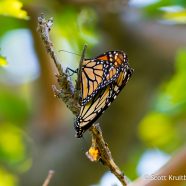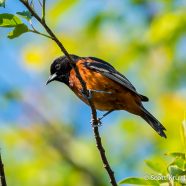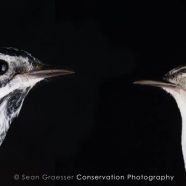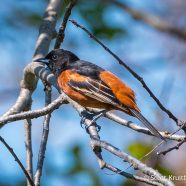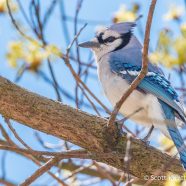Mated Monarchs
This was a memorable moment from last weekend – a mated pair of Monarch butterflies high up on a tree branch. Here’s to them having successful eggs, caterpillars and a healthy next generation. We need every butterfly we can get!
Read MoreOrchard Oriole
This adult male Orchard Oriole finally gave me a decent couple of poses on a recent morning! My guy was foraging, singing, and defending his territory against various avian intruders when he paused to let me shoot him for a few seconds. His chestnut-like tones look fantastic against the green leaves and blue sky. Someday I want to get a photo of an Orchard Oriole and a Baltimore Oriole for a better visual comparison of their sizes. Orchards are noticeably smaller than their cousins, just a bit larger than our vireos and warblers. It is hard to believe this fella will be heading south for the...
Read MoreBlack-and-white Warblers
Black-and-white Warblers (Mniotilta varia) were the most common migrant this spring in Connecticut for RTPI Affiliate Sean Graesser, and he even thinks that breeding individuals may stick around at Audubon Greenwich. This is male on the left and female on the right. Only now is their migration finally winding down after a tremendous season for the species.
Read MoreOrchard Oriole
This adult male Orchard Oriole (Icterus spurius) is a Stratford Point resident, deftly avoiding our cameras for the most part while feeding mostly in the canopy. Occasionally he drops down closer to eye level, and he has been seen copulating with our resident female. It is likely that we will once again have a nesting pair on site. The family grows up quickly though, and even by the end of July this guy may be heading back to Central America. When they are not vocalizing they can be surprisingly inconspicuous. This is probably the best time of year to get some good views of them without...
Read MoreBlue Jay
This Blue Jay (Cyanocitta cristata) was in the shade on a sunny April day, nevertheless showing off blue hues against a blue sky and flying around with its mate. In this case the blues are not as blue as they could be because they are not actually blue. Huh? Their feather barb cells are specially modified scatter light in a way that makes them appear blue instead of what would be brown melanin, and if this bird flew into the sunlight then it would pop even more. Scott Kruitbosch Conservation & Outreach Coordinator
Read More



